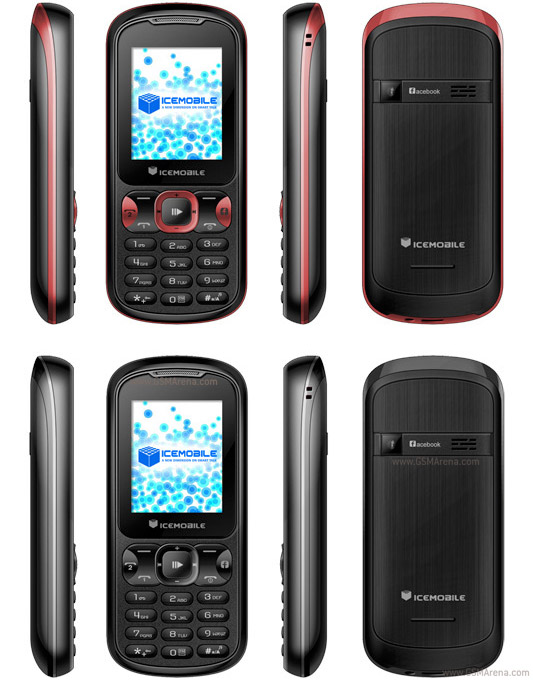
Overview of Icemobile Rock Mini
The Icemobile Rock Mini is a feature phone that was launched in March 2012. Although it is now discontinued, its compact design and basic functionality made it a popular choice for users seeking simplicity. With a weight of just 46 grams without the battery and dimensions measuring 103.2 x 45.2 x 14.5 mm, it is extremely portable and easy to handle. This phone comes with a dual SIM capability, allowing users to manage two different numbers simultaneously, which was particularly advantageous for business professionals or frequent travelers.
Design and Build
The Icemobile Rock Mini exhibits a classic design common among feature phones of its era. Crafted primarily from lightweight materials, the phone’s durability was a key attribute appreciated by its users. Available in multiple colors including Black, White, Red, and Silver, the phone provided a level of customization to suit different tastes. The compact form factor made it easy to slip into a pocket or a small handbag, a detail that was favored by users looking for convenience.
Display
The display of the Icemobile Rock Mini is a 1.8-inch TFT screen with a resolution of 128 x 160 pixels, offering a pixel density of approximately 114 ppi. Although modest by today's standards, the display was functional for basic phone operations such as calling, texting, and navigating simple menus. Its size contributed to the overall compactness of the device.
Camera
Equipped with a single 1.3 MP rear camera, the Rock Mini was capable of capturing basic photos and videos. While not designed for high-quality photography, the camera sufficed for capturing quick snapshots or documenting moments on the go. The lack of a front-facing camera means that selfies and video calls were not possible.
Network and Connectivity
The Icemobile Rock Mini operates on GSM technology, supporting 2G bands including GSM 850/900/1800/1900 for the first SIM. Unfortunately, it does not support modern connectivity options such as Bluetooth, WLAN, or positioning technologies. However, it does feature a stereo FM radio, providing an entertainment option for users.
Memory and Storage
The phone allows for a microSD card, which users could employ to expand storage beyond the phone's built-in capacity. Phonebook capacity was limited to 500 contacts, and it maintained call logs of up to 20 for dialed, received, and missed calls. The ability to extend the memory using an external card was a valuable feature, considering the limited internal storage typical of feature phones.
Battery Life
Powered by a removable Li-Ion 700 mAh battery, the Rock Mini offered a standby time of up to 180 hours and a talk time of up to 6 hours. This battery life was respectable for a feature phone, allowing users to go through the day without needing frequent recharges, which was a great advantage for those without constant access to a power source.
Sound and Audio
For audio, the Icemobile Rock Mini includes a loudspeaker but lacks a 3.5mm headphone jack. Users could enjoy listening to the stereo FM radio via the loudspeaker. This configuration is typical of feature phones, prioritizing basic functionality over advanced audio capabilities.
Operating System and Interface
The Rock Mini runs on a basic feature phone operating system, which supported fundamental functions such as SMS and MMS messaging. It did not support Java applications, which limited the scope of additional software users could run on the device. However, simple games were pre-installed providing some entertainment options.
Miscellaneous Features
Although lacking advanced technology seen in smartphones, the Icemobile Rock Mini was suitable for users whose main priorities included making calls, texting, and dual-SIM functionality. Its lightweight build and well-rounded feature set made it a favorable choice for individuals seeking reliability and simplicity rather than advanced technological capabilities.
Key Features of Icemobile Rock Mini
- Supports GSM Technology
- Dual SIM capability (Mini-SIM)
- Compact and lightweight with dimensions of 103.2 x 45.2 x 14.5 mm and 46 g without battery
- 1.8-inch TFT display with 128 x 160 pixels resolution
- Expandable storage via microSD card slot
- 1.3 MP main camera with video recording capability
- Includes a stereo FM radio
- MiniUSB port for charging
- Removable Li-Ion 700 mAh battery with up to 180 hours of standby time and up to 6 hours of talk time
- Available in multiple colors: Black, White, Red, Silver
Disadvantages of the Icemobile Rock Mini
- Limited network support with only GSM technology and no 3G or 4G capabilities.
- Lack of EDGE technology, resulting in slower internet browsing speeds.
- Very low screen resolution at 128 x 160 pixels, making for a poor display quality.
- No front-facing camera or selfie camera for video calls or selfies.
- Only a single 1.3 MP rear camera, which results in low image quality.
- No Bluetooth support, limiting wireless connectivity options.
- No WLAN (Wi-Fi) capability, restricting internet access solely to cellular data.
- Absence of GPS functionality, which restricts navigation capabilities.
- No standard 3.5mm headphone jack, limiting the use of common earphones and headphones.
- Uses miniUSB solely for charging, offering no data transfer capabilities.
- No sensors for advanced functionalities which are common in modern devices.
- Very low battery capacity of 700 mAh, which may not last a full day of active use.
- The device is discontinued, which may lead to difficulties in finding parts or support.

View Also
More Phones
All Rights Reserved +14266 Phones © Mobilawy 2025
























